Download Categories
Land and Governance, Women and Land Rights
Budget Analysis of Public Entities Managing Lands and Natural Resource Functions

2021-05-17
Kenya Land Alliance (KLA) partnered with the Institute of Economic Affairs (IEA) to do a budgetary analysis of public entities that managing land and natural resources functions in the county. More specifically, the budgetary allocations to the following Public Institutions the Ministry of Lands and Physical Planning (MoLPP) , The National Land Commission (NLC), the Ministry of Petroleum and Mining and the Ministry of Environmental and Forestry.
This analysis has brought in focus the public resourcing of the Community Land Registration process which was rolled out by the Government back in 2018.
Here is the the report:
0 downloads
A GUIDE ON PUBLIC LAND ACQUISITION WITHIN COMMUNITY LAND

2021-05-17
With the promulgation of the Constitution of Kenya, 2010 (CoK 2010), land was classified into public, private and community lands, occasioning the need for clear guidelines on acquisition of public land acquisition within the community land while appreciating the provision of the Community Land Act, 2016.
It is against this background that the National Land Commission (NLC) and KLA jointly developed a guide to give insights on requisite procedures
0 downloads
Accelerating Women and Girl's Rights in Kenya: The Role of the Alternative Justice Systems Policy in Kenya.
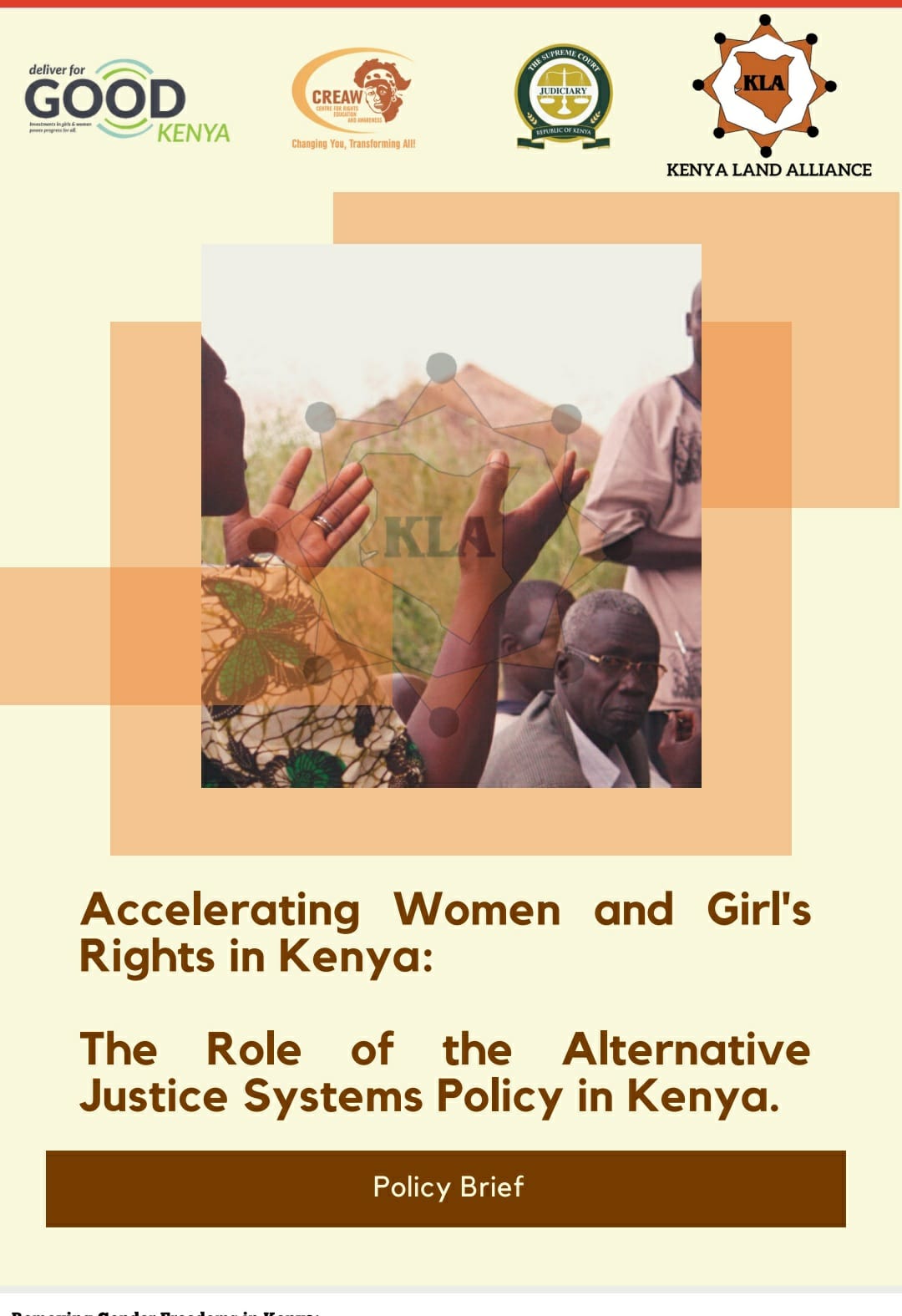
2021-10-22
Kenya Land Alliance in the past few months have reflected on the place of Alternative Justice Systems in advancing women and girl's rights, the policy brief below expounds on the matter,
0 downloads
LAND AND ELECTION VIOLENCE IN KENYA
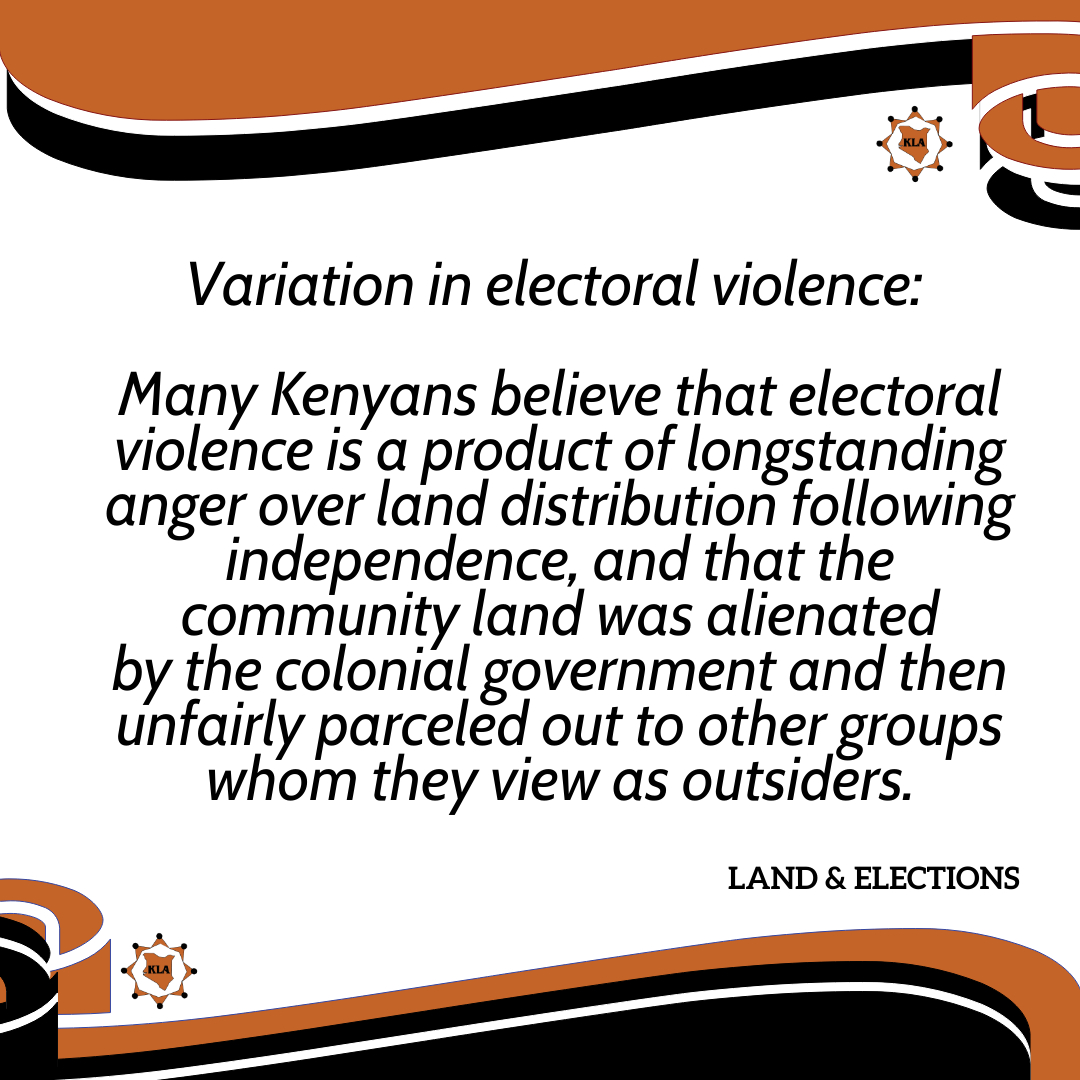
2021-10-26
This policy brief is based on a two-day consultative workshop convened by the Kenya Land Alliance (KLA), August 19-20, 2021, at the Boma Inn, Eldoret. It draws its findings and recommendations from the contributions by delegates from Government (National and County), academia, members of the public, civil society organizations (CSOs), and other non-state actors (NSAs). While the forum was by no means exhaustive on the emotive subject of land and elections in Kenya, the delegates present were unanimous that it provided a welcome entry point on starting a public conversation on the touchy topic of land and elections. The recommendations are captured in the last section of the report, which will form the rationale for the organizers to venture into more partnerships by way of funding through proposal writing
0 downloads
Women in the Artisanal Mining In Kenya
.jpeg)
2021-11-11
Kenya is endowed with a variety of minerals that include Gold, Copper, soda ash, fluorspar, titanium, manganese, iron ore, gypsum, diatomite, chromite, limestone, and silica sand among others⁸. There is a fair documentation of Kenya’s commercial mining and mineral processing operations. Mining is the industry and activities connected with getting valuable or useful minerals from the ground⁹. The mining sector in Kenya contributes about 0.4% of the country’s GDP.
Though mining activity has been present in the country for over 50 years, productivity has remained low. The scale of operations has been limited with only two projects - soda ash and mineral sands - comprising a large part of productive output by revenue. Exploration activity has also been limited even though geological surveys demonstrate a sizeable mineral potential¹⁰. For example, three of the four priciest gems in the world have been found in Kenya. This includes emeralds, sapphire, and ruby in Baringo and West Pokot among others¹¹.
0 downloads
Women In Artisanal Mining In Kenya: Economic Challenges And Opportunities
_(1).pdf)
2025-02-17
Women In Artisanal Mining In Kenya: Economic Challenges And Opportunities, a study of Kakamega, Kwale, Migori, Turkana and West Pokot Counties.
Kenya is endowed with a variety of minerals that include Gold, Copper, soda ash, fluorspar, titanium, manganese, iron ore, gypsum, diatomite, chromite, limestone, and silica sand among others. Though mining has been practiced in the country for over 50 years, productivity has remained low. The mining sector contributes only about 0.4% of the country’s GDP. The types of mining operations include large-scale, small-scale and Artisanal Mining (ASM).
The ASM sector is estimated to directly employ approximately 140,000 people (Ollett, 2013) and is undertaken in Migori, Narok, Siaya, Vihiga, Kakamega, West Pokot, Elgeyo Marakwet, Turkana, Laikipia, Tharaka Nithi, Kitui, Machakos, Taita Taveta and Kwale. As in the rest of the world, the ASM sector in Kenya will continue to grow.
The Extractives Hub (2020) attributes this trend to poverty, with ASM being widely recognized as a poverty-driven activity, capable of alleviating economic hardship and promoting wealth creation in largely rural communities. However, while ASM provides an income and potential route out of poverty, it can also keep women miners and their families trapped in poverty due to various challenges.
0 downloads
Ardhi Caucus Engagement Strategy on Land Tenure Security for All in Kenya.
.pdf)
2025-04-01
The Ardhi Caucus seeks to offer solutions to the challenges by fostering a united front and harnessing resources through a well-coordinat- ed approach. The Caucus, which involves both
state and non-state actors seeks to leverage oneach other’s technical expertise, capacities and
strengths towards expediting the actualization of gender transformative, community respon-
sive and inclusive land tenure security. Through the Caucus community, voices in different
spaces, from county to national levels will be amplified.
Objectives of the Caucus include:
• To become thought leaders on matters of land tenure by collectively developing evi-
dence-based action research-studies, policy, legal and administrative frameworks and
proposals to enhance land tenure security.
• To bolster the capacities of the different stakeholders towards the effective realization of tenure security.
• To mobilise resources towards the achievement of gender transformative land tenure security.
• To align climate change mitigation and adaptation strategies to the current trends/ discourse that promote land tenure security.
• To establish remedy mechanisms towards the facilitation of land tenure security in different contexts.
0 downloads
Audit of the Gender Responsiveness of Land Inventories Submitted for Unregistered Community Land in Kenya
.pdf)
2025-04-11
There is a strong positive correlation between women’s secure land rights and their well-being. Land is a fundamentally critical resource for women’s survival and achievement of sustainable development. It is a source of livelihood, thereby overwhelmingly cementing women’s critical space in food production especially provision of labour in agriculture.
In Kenya, land remains a major source of disparity and conflict among many social groups and its access, us e and control are at the heart of the National Land Policy 2009, the Constitution of Kenya 2010 and subsequent legislations including the Land Act 2012 as well as Community Land Act 2016. Truly, Kenya has made positive progress in realizing gender agenda including the promotion and embedment of gender equality and non-discrimination in policies, laws, strategies and action plans.
Evidently, non-discrimination stands out as a critical value and principle in Article 10 of the Constitution that underpins socio-economic and political development as well as governance spheres in the Republic. Despite these constitutional and legal requirements relating to inclusion of women and other marginalized groups in governance, there is a disconnect between policy and practice, giving rise to un-intended misnomer regarding the nexus between de facto and de jure gender equality.
0 downloads
A GUIDE FOR THE DEVELOPMENT OF COMMUNITY LAND BY-LAWS IN LINE WITH THE COMMUNITY LAND ACT, 2016
_(2)_(1).pdf)
2025-04-15
The enactment of the Community Land Act, 2016 presents a paradigm shift from the land registration system propagated circa 1950s in which security of rural tenure lay in the extinction of customary rights and their replacement with freehold or leasehold entitlements issued to individuals or corporate entities.
Under the Community Land Act, 2016, each community may, if it wishes, secure a single collective title over all or part of its lands, and lawfully govern this property. This includes regulating traditionally ‘private’ possession of portions of land within the community domain, as allocated to individual families for settlement or farming purposes. Customary practices may be applied within constitutional parameters of human and social rights.
In spite of the great prospects of the Community Land Act, 2016 its implementation has been slow due to administrative challenges including the problematic understanding the provisions of the Act by various stakeholders and dismal mobilization of resources for effective implementation. This has in turn created challenges for agencies, institutions and private investors interested in undertaking development projects in Community Land.
Per Section 7 of the Act, in concert with Section 15, the process of registration of Community Land commences with the application to the Community Land Registrar of an application for recognition of interest in or right over community land by representatives of a particular community.
This is followed by a series of actions guided by the Constitution of Kenya, including the election of the Community Land Management Committee to oversee the day-to-day administration and management of the community land on behalf of the community. This committee prescribes and submits to the Community Land Registrar, the rules and regulations to govern the operations
of the community in relation to land.
0 downloads
Judgement of the Supreme Court on land ownership when a lease expires and is not officially renewed
)
2025-04-15
The appellants, alongside the late Harcharan Singh Sehmi (whose case abated at the Court of Appeal following his passing on in 2019), were the registered proprietors of L.R. No. 209/2759/9 (I.R. 6477), situated in the Ngara area of Nairobi (hereinafter referred to as the “suit property”). They had acquired the SC PT No. E033 of 2023 Page 3 of 43 property in 1968 from Elizabeth Ann Maria Estreta Rodrigues for a consideration of Kshs. 25,000/- and were duly registered as tenants in common.
The tenure of the property was a leasehold for a term of fifty-nine (59) years commencing on 1st October 1942 and was scheduled to expire or for extension on the 1st October 2001. However, in October 2014, they were forcibly evicted from the property by the 1st and 2nd respondents who laid claim on the property under a separate title bearing a new I.R. number, L.R. No. 209/2759/9 (I.R 12263).
The Supreme Court has unequivocally affirmed that upon the expiry of a lease, if it is not formally renewed, the leasehold interest is extinguished in its entirety. The land in question automatically reverts to the Government, transforming from a private leasehold back into public land.
The court's position is clear: continued occupation or payment of land rent/ rates does not override the fundamental principle that a lease, once expired and unrenewed, ceases to have any legal effect.
0 downloads
THE RURAL WOMEN’S LAND RIGHTS CHARTER: Towards Achieving Women's Land Rights

2021-03-24
The Rural Women’s Land Rights Charter of Kenya is a bold expression of the concerns/ issues and their aspirations of women living in rural areas on land matters. At the core of these aspirations is the realization of secure and protected women’s land rights and security for their land-based livelihoods.
Women from rural areas in 24 counties in Kenya highlighted their issues and expressed the kind of change they would like to see on matters land through the Rural Women’s Land Rights Charter. Rural women in a breakfast launch in Nairobi proclaimed this charter on October 13th 2016. During this launch, the Cabinet Secretary in charge of the Ministry of Lands and Physical Planning and the Chairperson of the National Land Commission committed their institutions to fully implement the demands.
196 downloads
Gender Aspects of Land Reform Constitutional Principles

2021-03-25
In this pocket size booklet, Land Reform Volume 4, KLA proposes that collectively as a nation, and especially during this time of the constitutional review process; we must provide women a deliberate opportunity to engage in decision-making as regards land-use,management and ownership.
66 downloads
The National Land Policy in Kenya Critical Gender Issues and Policy Statements

2021-03-25
The purpose of this Issues Paper is to move the debate and stimulate discussion of issues relevant to women’s land rights and social security beyond the unfulfilled demands for gender responsive land policies and land legal framework. It is based on lessons learned from various research findings, Kenya Land Alliance experience and discussions with colleagues with whom we work with in various capacities on land policy and law reforms in Kenya and others parts of Africa.
52 downloads
Kenya Land Issuance Disaggregated Data Analysis

2021-03-25
This booklet reveals that women only got 103,043 titles representing 10.3 percent, while men got 865,095 titles representing 86.5 percent of the total. The glaring disparity is made clear when looked at against the actual land sizes and titled for women against men. The data sample shows that out of 10,129,704 hectares of land titled between 2013 and 2017 women got 163,253 hectares representing a paltry 1.62 while men got 9,903,304 hectares representing 97.76 percent.
205 downloads
Strengthening Women’s Voices in the Context of Agriclutural Investments: Lessons From Kenya
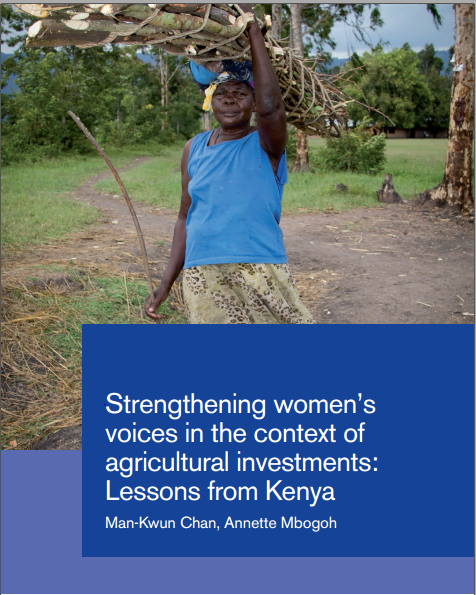
2021-03-25
This report, which focuses on Kenya, constitutes one of four country-wide assessments produced under the overall project. It draws on a literature review conducted by the Kenya Land Alliance (KLA) with additional inputs from IIED, as well as on primary field research conducted by KLA in April 2016 (see Section 1.2 for further information about the research methodology). The primary aim of this report is to inform practitioners, policy makers and researchers about key governance issues relevant to the strengthening of women’s empowerment in community land stewardship and accountability in agricultural investments in Kenya.
85 downloads
Land & Property Rights
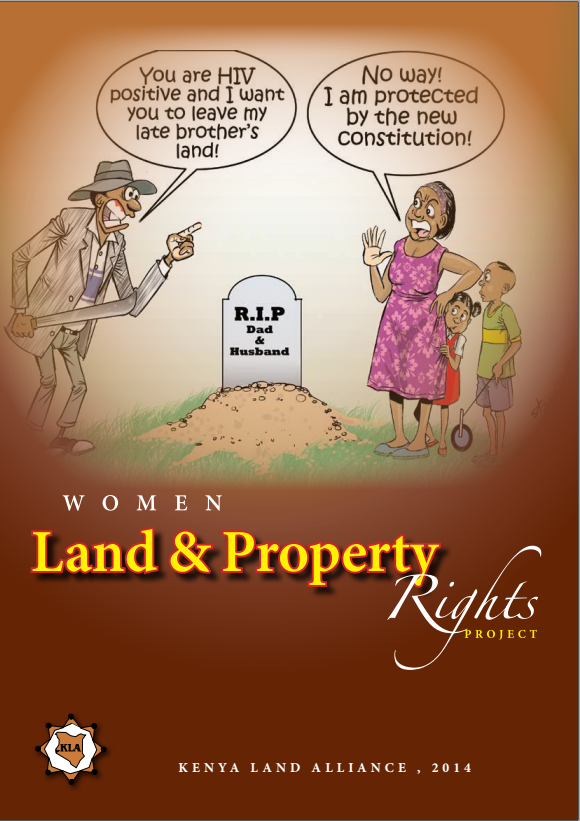
2021-03-25
The women Land Rights Project is a project of Kenya Land Alliance that aims at actualisation Women land and property rights, as provided in the Constitution of Kenya, 2013 and as a means towards poverty alleviation. This considering the fact that, in Kenya where the foundation of most communities is Agriculture and livestock production, women contribute up to 80% of workforce yet they only hold 1% of registered land in their names and around 5-6% of registered titles are held in joint names (Kenya Land Alliance, 2013).
70 downloads
IMPACT OF THE COVID -19 PANDEMIC ON WOMEN IN THE ARTISINAL MINING SECTOR IN Kenya

2021-05-17
KLA undertook a study to highlight the impacts and emerging hidden dimensions of the COVID-19 pandemic on Women in the artisanal mining sector across the Country. From the in depth analysis, it is evident that the pandemic disproportionately affected at least 28 percent of women who depend on small scale mining for their livelihood. Six Counties were sampled i.e Taita Taveta, Migori, Kilifi, Kakamega, Kitui and Kwale.
0 downloads
Accelerating Women and Girl's Rights in Kenya: The Role of the Alternative Justice Systems Policy in Kenya.

2021-10-22
Kenya Land Alliance in the past few months have reflected on the place of Alternative Justice Systems in advancing women and girl's rights, the policy brief below expounds on the matter,
0 downloads
LAND AND ELECTION VIOLENCE IN KENYA

2021-10-26
This policy brief is based on a two-day consultative workshop convened by the Kenya Land Alliance (KLA), August 19-20, 2021, at the Boma Inn, Eldoret. It draws its findings and recommendations from the contributions by delegates from Government (National and County), academia, members of the public, civil society organizations (CSOs), and other non-state actors (NSAs). While the forum was by no means exhaustive on the emotive subject of land and elections in Kenya, the delegates present were unanimous that it provided a welcome entry point on starting a public conversation on the touchy topic of land and elections. The recommendations are captured in the last section of the report, which will form the rationale for the organizers to venture into more partnerships by way of funding through proposal writing
0 downloads
Women in the Artisanal Mining In Kenya
.jpeg)
2021-11-11
Kenya is endowed with a variety of minerals that include Gold, Copper, soda ash, fluorspar, titanium, manganese, iron ore, gypsum, diatomite, chromite, limestone, and silica sand among others⁸. There is a fair documentation of Kenya’s commercial mining and mineral processing operations. Mining is the industry and activities connected with getting valuable or useful minerals from the ground⁹. The mining sector in Kenya contributes about 0.4% of the country’s GDP.
Though mining activity has been present in the country for over 50 years, productivity has remained low. The scale of operations has been limited with only two projects - soda ash and mineral sands - comprising a large part of productive output by revenue. Exploration activity has also been limited even though geological surveys demonstrate a sizeable mineral potential¹⁰. For example, three of the four priciest gems in the world have been found in Kenya. This includes emeralds, sapphire, and ruby in Baringo and West Pokot among others¹¹.
0 downloads
Audit of the Gender Responsiveness of Land Inventories Submitted for Unregistered Community Land in Kenya
.pdf)
2025-04-11
There is a strong positive correlation between women’s secure land rights and their well-being. Land is a fundamentally critical resource for women’s survival and achievement of sustainable development. It is a source of livelihood, thereby overwhelmingly cementing women’s critical space in food production especially provision of labour in agriculture.
In Kenya, land remains a major source of disparity and conflict among many social groups and its access, us e and control are at the heart of the National Land Policy 2009, the Constitution of Kenya 2010 and subsequent legislations including the Land Act 2012 as well as Community Land Act 2016. Truly, Kenya has made positive progress in realizing gender agenda including the promotion and embedment of gender equality and non-discrimination in policies, laws, strategies and action plans.
Evidently, non-discrimination stands out as a critical value and principle in Article 10 of the Constitution that underpins socio-economic and political development as well as governance spheres in the Republic. Despite these constitutional and legal requirements relating to inclusion of women and other marginalized groups in governance, there is a disconnect between policy and practice, giving rise to un-intended misnomer regarding the nexus between de facto and de jure gender equality.
0 downloads
Audit of the Gender Responsiveness of Land Inventories Submitted for Unregistered Community Land in Kenya
_(1).pdf)
2025-05-26
Kenya has made positive progress in realizing gender agenda including the promotion and embedment of gender equality and non-discrimination in policies, laws, strategies and action plans. Evidently, non-discrimination stands out as a critical value and principle in Article 10 of the Constitution that underpins socio-economic and political development as well as governance spheres in the Republic.
Despite these constitutional and legal requirements relating to inclusion of women and other marginalized groups in governance, there is a disconnect between policy and practice, giving rise to un-intended misnomer regarding the nexus between de facto and de jure gender equality.
0 downloads
Undocumented and Disempowered: A Baseline Study on Emergent Property Rights Issues Amongst Immigrant Tanzanian Women in Taita Taveta County.
2.pdf)
2025-07-25
Having a legal identity is a basic right and provides the key to access services and opportunities. In Taita Taveta County, about 30% of women lack basic documents required for land acquisition, economic empowerment and succession processes. The issue is particularly acute for those women from Tanzania but married in Kenya, who face compounded challenges due to lack of proper identification documents.
Many of these women are unaware of their rights, making them vulnerable to land tenure insecurity. Additionally, local administrative officers were found to be either ignorant of the situation or complicit in denying women their rights.
Utilizing Kenya Land Alliance extensive experience in land rights advocacy and community mobilization, Imarisha Wajane Project intended to engage relevant authorities and key stakeholders to better understand and respond to these women's needs. As a result, a baseline study was conducted to analyze the status of women's land rights and economic empowerment, focusing on the challenges posed by lack of proper documentation among Tanzanian women residing in Taveta, Kenya.
0 downloads
REPORT- Undocumented and Disempowered: A Baseline Study on Emergent Property Rights Issues Amongst Immigrant Tanzanian Women in Taita Taveta County.
_Monday.pdf)
2025-07-28
Having a legal identity is a basic right and provides the key to access services and opportunities. In Taita Taveta County, about 30% of women lack basic documents required for land acquisition, economic empowerment and succession processes. The issue is particularly acute for those women from Tanzania but married in Kenya, who face compounded challenges due to lack of proper identification documents.
Many of these women are unaware of their rights, making them vulnerable to land tenure insecurity. Additionally, local administrative officers were found to be either ignorant of the situation or complicit in denying women their rights.
Utilizing Kenya Land Alliance extensive experience in land rights advocacy and community mobilization, Imarisha Wajane Project intended to engage relevant authorities and key stakeholders to better understand and respond to these women's needs. As a result, a baseline study was conducted to analyze the status of women's land rights and economic empowerment, focusing on the challenges posed by lack of proper documentation among Tanzanian women residing in Taveta, Kenya
0 downloads
INTERNATIONAL DAY OF RURAL WOMEN 15TH OCTOBER 2018 PROGRESS IN ADDRESSING WOMEN LAND RIGHTS – RETRACING THE JOURNEY

2021-03-25
THEME: “Sustainable infrastructure, services and social protection for gender
equality and the empowerment of rural women and girls”
Time is now to transform rural women’s lives. Rural women make up the majority of Kenya’s agricultural labour force. They ensure food security for their communities and build climate resilience in this time of the challenges of climate change. But their crucial role they play in ensuring the sustainability of rural households and communities, improving rural livelihoods and overall wellbeing, forces us to ask the basic questions flagged by Professor Henry Bernstein in his book on Class Dynamics of Agrarian change, 2010 of: who owns what?, who does what?, who get what?, and what do they do with? As we commemorate 10 years since the first International Day of Rural Women was established on 15th October 2008. We need to ask these right questions in recognition of the substantial proportion of the women’s agricultural labour force, including informal work, and performance of the bulk of unpaid care and domestic work within families and households in rural areas. Women make significant contributions to agricultural production, food security and nutrition, land and natural resource management, yet structural barriers and discriminatory social norms continue to constrain women’s decision-making power and
political participation in rural households and communities. This year marks the second anniversary of the Women to Kilimanjaro Initiative. This initiative culminated in the launch of the Rural Women’s Land Rights charter for Kenya and the Africa wide charter on rural women land rights. It is therefore an appropriate moment to take stock of the progress made so far and what lies ahead.
127 downloads
The Land Sector Non State Actors (LSNSA) is a network of civil society organizations working together to promote secure and equitable access to land and natural resource for all through advocacy, dia
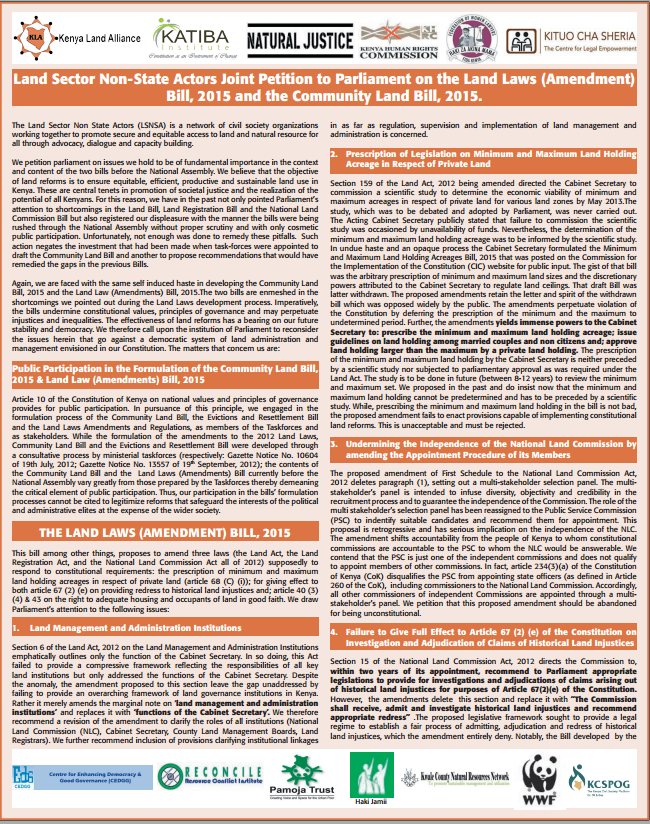
2021-03-25
The Land Sector Non State Actors (LSNSA) is a network of civil society organizations working together to promote secure and equitable access to land and natural resource for all through advocacy, dialogue and capacity building. We petition parliament on issues we hold to be of fundamental importance in the context and content of the two bills before the National Assembly.
62 downloads
Land-Laws-Amendment-Bill-2015
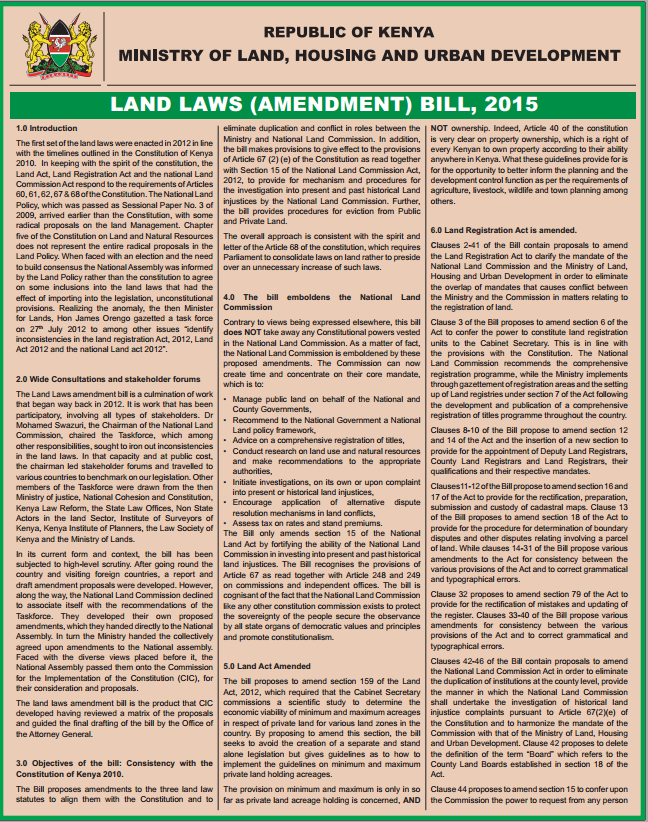
2021-03-25
The first set of the land laws were enacted in 2012 in line with the timelines outlined in the Constitution of Kenya 2010. In keeping with the spirit of the constitution, the Land Act, Land Registration Act and the national Land Commission Act respond to the requirements of Articles 60, 61, 62, 67 & 68 of the Constitution.
51 downloads